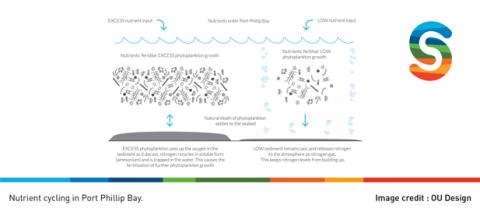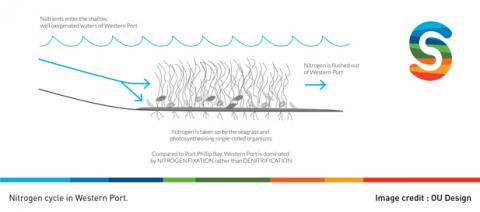As part of our campaign to celebrate Victoria’s marine environment, this week we share some background on the chemistry of Port Phillip Bay and Western Port from the State of the Bays (SotB) 2016 report and look at their different nitrogen cycles. Nitrogen is an essential nutrient for the growth of marine life: the nitrogen cycle plays a key role in maintaining water quality.
Both bays have clean and healthy nitrogen cycles compared with similar bays close to population centres around the world. Port Phillip Bay is a ‘biologically’ dominated system – that is, it is dominated by phytoplankton. By contrast, Western Port is a ‘biophysically’ dominated system – that is, it is governed by shore morphology, wave dynamics, wind and light.

In Port Phillip Bay, it is denitrification that is the process which maintains water quality, removing Nitrogen from the system and releasing it into the atmosphere. How efficiently this is done is described as ‘denitrification efficiency' (DE).
- When DE is high, less nitrogen recycles and phytoplankton growth is limited.
- When DE is low, phytoplankton proliferate, which leads to decreased water quality and the threat of algal blooms.

By contrast, there is very little denitrification in Western Port, which is a well-flushed, significantly vegetated bay with the opportunity for a lot of light to reach the sediment. This means that there is both seagrass and microphytobenthos (MPB), which have a high demand for nitrogen. Nitrogen fixation governs its nitrogen cycle, incorporating nitrogen into the system.
For a healthy Western Port, the ratio of nitrogen fixation to denitrification should be higher. Western Port is generally considered to have low nutrient inputs relative to other bays such as Port Phillip Bay. In State of the Bays (SotB) 2016, we reported that, on average, Western Port receives around 650 tonnes of nitrogen a year from the catchments, around 430 tonnes a year from nitrogen fixation and loses around 230 tonnes per year through denitrification. We invite you to head to the Water Quality page of our interactive State of the Bays website here and access the SotB 2016 report – the next iteration of the report will include an expanded scope and be titled the Victorian State of the Marine and Coastal Environment 2021 report - currently in preparation by the #CommissionerforEnvironmentalSustainability. https://lnkd.in/gB5Z4ey
Quick fact
Did you know that Victoria is one of only two jurisdictions in Australia (the other being the ACT) with an independent Commissioner charged with periodic State of the Environment reporting? Read about Victoria’s Commissioner for Environmental Sustainability.
